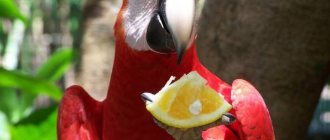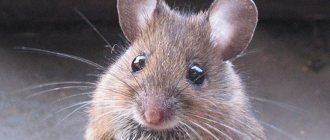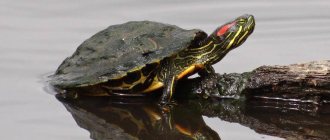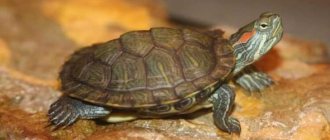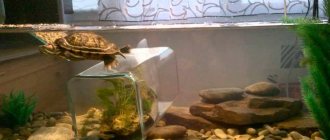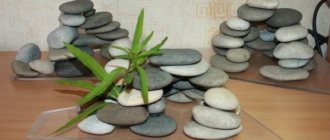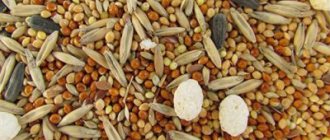What do turtles eat in the wild?
The main component of the diet of red-eared turtles in the wild are shellfish: mussels and snails, oysters, and crustaceans. They have no teeth, but this does not prevent them from excellently dealing with mollusk shells: with strong jaws they break them and eat the pulp.
In the summer, insects become food for turtles: grasshoppers, beetles, etc.
They are very fond of algae, plankton and small fish. They also eat tadpoles, fish fry and frogs.
Reproduction at home
When turtles live in their natural environment, they begin to reproduce only after reaching 6-8 years of age. When turtles are kept in an artificial environment, they are ready to reproduce at a maximum of 5 years of age. Under natural conditions, the reproduction process begins at the end of February and lasts until May. Having met a female, the male tries to position himself as close to the female’s head as possible.
When the time comes to lay eggs, the female leaves the pond and heads to land, where she begins to search for a suitable place. After this, she wets the soil with water, which she prudently stored in the anal bladders. Then the female begins to form a nest.
To do this, she uses her hind legs. As a result of the active actions of the turtle, a ball-shaped nest is formed, the diameter of which, depending on the type of turtle, can reach up to 7-25 cm.
The female lays from five to twenty eggs at a time, the diameter of which is up to 4 cm on average. After this process, the turtle covers them with soil. Turtles do not care about their future offspring and immediately climb back into the sea (into the water). Eggs develop at temperatures from +21 to +30 degrees for 3-5 months. When the development of eggs occurs at a temperature of +27 degrees and below, then males are born, and when at a temperature of about +30 degrees and above, females are born.
A crowd of red-eared turtles!
Watch this video on YouTube
Diet of the red-eared slider
A necessary aspect of caring for turtles is preparing the right diet. The health of your pet depends on feeding high-quality, fresh and, importantly, varied food.
In captivity, this reptile has little demand for food. For a tough shell and healthy skin, reptiles require both plant and animal products. For turtles up to one year old, the latter must be included in the diet in an amount of 80% or more.
A reptile's hard shell requires plant and animal products.
Mature turtles need to increase the amount of plant foods rich in fiber and vitamins. As a result of eating only meat, pets can develop rickets, hypovitaminosis or obesity.
The required vitamins and dietary supplements must be regularly added to food.
Recommendations for how many times per day to feed your red-eared slider will depend on the age and preferences of the individual reptile.
Red-eared turtle babies up to 1-1.5 years old should have one or two meals a day. If you have no appetite, reduce the amount of food or go on a short hunger strike for 1-2 days.
To create an optimal nutritional regimen for an adult, you should observe the pet and feed it on demand. If a turtle is hungry, it becomes overly active in the presence of its owner, hitting the water with its paws. After feeding, she calms down and rests calmly. A turtle may require food daily, or maybe once every 7 days.
The number and size of feeding portions also depends on the type of food. If a turtle has a balanced menu, it can refuse food even for several days.
A turtle may require food daily, or maybe once every 7 days.
The constant presence of live plant food in the aquarium also affects the frequency of feeding.
When the red-eared turtle does not ask for food itself, you can give it food once a day. If she eats everything well, then continue to feed her that way. In case of malnutrition of a significant amount of food, you should try to feed it once every 2, 3-7 days, that is, find out its needs experimentally.
It is important not to overfeed the animal; it is better to leave it a little hungry, but healthy.
What do herbivores like?
Most of the food for herbivorous turtles should be fresh greens; it is better to give the animals salads, leaves, and herbs.
1/5 of the diet may include vegetables: carrots, zucchini, pumpkin, unsweetened fruits are acceptable in moderation. A small slice of apple or pear once a week will please your pet and will not cause harm to its health. It is imperative to dilute the diet with specialized food for turtles, bran, soybean meal, and dry yeast. However, the following foods should not be given to vegetarians:
- meat in any form, including minced meat;
- fish;
- food for cats or dogs;
- bread.
A competent approach to nutrition will allow the animal to remain healthy and active for many years, delighting the owner with its funny antics.
Basic feeding rules
To properly feed a red-eared turtle, you must comply with the basic conditions and some subtleties:
- Any food needs to be cut into pieces: the smaller the turtle, the smaller the pieces.
Any food needs to be cut into pieces
- Aquatic reptiles tear large pieces with their sharp claws, so that plant food can be fed whole.
- Before serving, products must be washed, seeds and peels removed.
- The pet should eat the food within 30 minutes. The serving size should be calculated based on this indicator, and should not exceed half the size of the shell. You can also give pieces of food the size of the reptile's head.
- Feed should be given at room temperature. Very cold food is harmful to your pet's health.
- Turtles search for food using their vision. The more attractive the color of the food, the faster she will find and eat it. For this you can use carrots and tomatoes.
- It is better to feed your pet in the morning, but it is not essential. It is important that she has time to digest what she eats during daylight hours or with the lamp on.
- Uneaten food must be immediately removed from the reservoir - this way the reptile will develop the habit of eating at certain hours.
There are different ways to feed armored animals: with tweezers, from a special bowl, or by throwing them into water.
You can feed red-eared turtles with tweezers
It is best to feed the red ear in another aquarium or basin, because leftover food will contaminate the terrarium, and the water will have to be replaced frequently.
You can also teach him to eat on an island equipped in the aquarium. First, food is placed at the very edge of the shore near the water. If the reptile is hungry, it will have to take food. So gradually get used to eating from a small saucer with water.
You should not hand feed your reptile too often to avoid getting used to this method of feeding and refusing to eat differently. There is also a risk of being bitten.
You cannot distract your pet while eating: sudden movements and loud sounds frighten him.
How often?
And another significant issue for turtle owners is the frequency of feeding.
Here, there is no need to focus on how often the red-eared turtle feeds on something, if you do not put restrictions on it - these creatures are not endowed with increased intelligence, and eat as much as food appears within reach. Therefore, it is recommended to give food to very small turtles a couple of times a day, and to those that have reached adulthood – once every two to three days (but in sufficient quantities).
The volume of food is the size of 2 pet heads.
Between main meat meals, you can feed with plant foods - washed duckweed, pieces of vegetables or fruits. And don’t be afraid to leave your pets hungry – it’s even good for them; overfeeding is much more harmful than underfeeding!
Author - Dasha Blinova, website www.sympaty.net - Beautiful and Successful. This article has been checked and approved by a veterinarian. Knyazeva Anna Vladimirovna, veterinarian in private practice, Moscow. Learn more about the site's authors. Copying this article is prohibited!
What can you feed your red-eared slider?
At home, you can use special food purchased at a pet store to feed your red-eared reptile.
For the main diet, meat and offal, cottage cheese and eggs are used, as well as fish, seafood and insects. The use of various types of plants, vitamin and mineral supplements is recommended.
Animal feed
This food serves as the basis for the diet of aquatic turtles. For a growing animal, the portion size and variety of food should be increased.
Red-eared turtles prefer live food: snails, small fish, insects and crustaceans. Such nutritional components will be good for diversifying your diet, but you shouldn’t get too carried away with them. It is enough to apply them 2 times a month.
Red-eared turtles prefer live food, but you shouldn’t get carried away with it
Food can be served either raw or cooked, unsalted and unseasoned, divided into pieces.
Meat
The red-eared slider's diet may include lean beef, horse meat, rabbit, chicken and turkey.
Reptiles also eat minced meat. Finely chopped plant food is added there if the turtle refuses it.
By-products
By-products should be added systematically to the red ear's diet. From a wide variety, you should choose only beef or poultry liver and heart. They contain a significant amount of vitamin A, which helps normalize the growth of the pet and maintain healthy skin. Due to a deficiency of this vitamin, detachment of the horny scutes, development of conjunctivitis, etc. are possible.
By-products should be added to the diet systematically
It is recommended to give liver only to adult turtles once every 30 days.
Cottage cheese and eggs
It is difficult to feed cottage cheese to replenish calcium levels to a turtle - it disintegrates in water. But they like to catch it and eat it.
Eggs are used raw, mixed with various types of products.
Fish and seafood
Fish is recommended in raw low-fat varieties (up to 3.0%), such as hake, blue whiting, pollock and cod, and freshwater perch. River species are best suited.
Before feeding, you can remove large bones from the fish, but leave the giblets, because the turtle needs all the useful substances contained in the fish to maintain the rigidity of the shell and skeleton as a whole.
In order to eliminate the negative effects of thiaminase in raw fish, immediately before feeding, it is necessary to put it in hot water for 2 minutes.
Among marine products, green shrimp are used as food for reptiles; they enjoy octopus and squid, and eat mussels and snails.
Reptiles enjoy eating octopus, squid, and shrimp.
If there are fish or frogs living with the turtle, there is a high chance that it will eat them.
Insects
The menu of the red-eared turtle should include insects: beetles and hairless caterpillars. He loves to eat grasshoppers and crickets, earthworms, and also eats mealy bug larvae.
In summer they are collected in the garden and park. But you can’t collect it where it has been treated with chemicals.
Cockroaches caught at home should absolutely not be given in order to avoid insecticide poisoning.
Pet stores sell bloodworms and mealworms to feed armored reptiles.
It is recommended to purchase gammarus - small dried crustaceans. It contains a significant amount of calcium. Koretra and daphnia are also suitable food for your pet.
Insects are used as food for the turtle 1-2 times a week.
Fruits
All types of fruits contain many vitamins.
To the question whether a red-eared turtle can have an apple, there is one answer - you can also have a pear, a banana, an orange and a peach, or a plum and an apricot. Only citrus fruits should be peeled.
You can give your red-eared turtle apple, pear, banana and other fruits.
It is also recommended to occasionally give strawberries, wild strawberries, and pamper your pet with raspberries and other berries. The turtle can also have melon and watermelon.
Vegetables
Vegetables are rich in fiber, which is very beneficial for the gastrointestinal tract, and in particular, the process of food absorption, as well as vitamins A and K, calcium.
These reptiles eat cucumbers, zucchini, cabbage leaves, and red tomatoes, bright sweet peppers, pumpkins, carrots and beets attract their attention. You can even offer beans and asparagus.
They are given raw, without signs of spoilage and without mold. Cooked vegetables have no benefit for the turtle.
Mushrooms
Along with vegetable and fruit food, the red ear can be fed once every 7 days with mushrooms: slices of russula, champignons and boletus.
Greens and plants
These products are also important in the diet of turtles. They must consume them at least 50% of the total diet, and for older turtles this figure reaches 75%.
It is also recommended to feed these reptiles indoor plants, for example, thornless cacti and agave, tradescantia, hyacinth and hibiscus. It is very useful to feed with herbs from meadows, dandelion, coltsfoot, as well as plantain and clover. These reptiles have a good appetite for carrot and beet tops, lettuce leaves, basil and parsley, and dry hay. It is recommended to feed with sprouted wheat or oats (cut sprouts 5-10 cm).
These reptiles have a good appetite for carrot and beet tops
The greens are picked in the garden or in the forest far from roads, sorted and washed.
Aquatic plants, for example, duckweed, hornwort, pistia, water hyacinth, etc. are extremely useful for these reptiles.
It is better to breed them separately. After all, the algae growing in an aquarium with red ear is constantly plucked by it, which disrupts the landscape design. Having eaten algae, she may not accept other food.
Duckweed can be caught from a nearby pond.
Toxic algae (elodea and limnophila) are destructive to turtles.
Features of handling a pet
Red-eared turtles should not be allowed on the floor. They can bite, hiss and show aggression; you should handle it carefully when picking it up; it is recommended to hold the reptile with both hands; the shell can be quite slippery. After contact with pets, hands must be washed with soap; a large number of pathogenic bacteria accumulate on the shell.
Living in their natural environment, turtles independently obtain all the vitamins and minerals necessary for health. In a home environment, the owner must independently add important elements to the feed.
Mandatory list of useful substances:
- vitamins d3, A and E;
- calcium;
- minerals.
All additives must be added strictly following the instructions and recommendations; any overdose is dangerous for the life of the individual.
Walks
A red-eared turtle kept at home needs walks in the summer. Thus, it becomes possible to get a dose of ultraviolet rays, eat healthy grass, and breathe fresh air. The place for a walk should be clean, away from the road, with lawn grass.
The temperature in the shade should not exceed 20 degrees, and the walking time should not exceed half an hour. When walking, there should be water in a visible, accessible place. In order not to lose your pet among the green grass, it is recommended to attach a bright mark, for example, orange, to the shell, it can be a sticker or a flag.
Care and hygiene
It is recommended to arrange water treatments for pets at least once a week. Waterfowl turtles need more frequent bathing or a bathing container in their terrarium. Water for bathing should be warm, but not more than 32 degrees, boiled if possible. The fluid level must be comfortable for standing with your head retracted.
Bathing a turtle
During the first bath, you should carefully monitor the procedure to avoid frightening the animal. If the reptile does not feel well in the water and refuses to bathe, it is recommended to limit itself to spraying the shell and skin. If the bathing container is freely accessible inside the terrarium, the liquid must be changed every day.
It is recommended to use a cloth or sponge for washing; they must be soft. The use of chemicals is prohibited. For preventive measures against fungus, methylene purchased at a pet store is used. After each contact with water, the turtle should have the opportunity to dry and warm up under an ultraviolet lamp. She cannot tolerate temperature changes in the aquarium, which increases the risk of colds.
Artificial feed
Pet stores have a wide variety of balanced foods specifically for armored reptiles. They can come in various forms: capsules, tablets, granules and even flakes. And their compositions will vary. But for the most part, the food produced by the manufacturer often does not satisfy all the needs of the reptile’s body.
In essence, turtle food is food for aquarium fish that has been improved to meet the needs of the reptile's body. Due to the specific smell, pets may even ignore it, but over time they get used to it.
This type of feeding is convenient, but you cannot feed it alone
This type of feeding is convenient primarily for busy people, but it is not the only way to feed. Such feeds often do not maintain the balance recommended by veterinarians, which can lead to vitamin deficiency and digestive problems for the animal.
Mineral mixtures and vitamins
It is necessary to feed the aquatic turtle with vitamin and mineral mixtures. Active growth, healthy skin, and proper development of the skeleton and bone tissue depend on them.
Aquatic turtles receive useful substances not only from a variety of foods, but also from special supplements. The diet of such a pet should contain moderate amounts of vitamins A, B12, D3, E, as well as minerals such as selenium and calcium.
Regular feeding with calcium-containing preparations is especially important for turtles to strengthen their shells, especially in growing young individuals. With calcium deficiency, it can become crooked and lumpy. Claws may also become bent, limbs may occasionally break, and in extreme cases, the shell may even fall apart or become like cardboard. In nature, sources of calcium for turtles are limestone, oyster shells, corals, dolomites, and animal bones.
Calcium-rich foods include the popular gammarus. A significant amount of it is found in bone meal, ground egg shells, and also in feed chalk. They are given 100 mg of the mixture per 1 kg of pet’s weight once every 7 days.
The most applicable drugs are purchased at a veterinary pharmacy or pet store.
Feed containing vitamins and minerals (except calcium) cannot be stored for a long time. Vitamins for the prevention of vitamin deficiency C and E and mineral supplements are given only once a month, mixed into the food.
Vitamins and mineral supplements are given only once a month, mixed into the food
To ensure that the turtle consumes all the added nutrients, you should mix them with food and feed them by hand.
Ready-made food in a pet store
Dry food for red-eared turtles can be used only in cases where it is not possible to maintain a balanced diet using natural products.
Although manufacturers promise to fully satisfy the reptile’s needs for the necessary substances, they do not recommend making semi-finished products a monotypic type of food in order to avoid metabolic disorders and problems in the gastrointestinal tract.
Food for cats and dogs
It is not recommended to use either dry or wet dog or cat food for feeding red-eared turtles.
This combination food is specially developed in the optimal ratio for feeding warm-blooded animals, so it is not suitable for reptiles. It contains a set of substances that are absolutely useless for turtles.
Vitamin and mineral supplements for these pets also do not meet the needs of the turtle’s body.
Homemade food for red-eared turtles
It is possible to prepare food for pets with shells yourself at home.
For this you will need:
- cabbage – 50 g;
- squid meat – 100 g;
- lean fish – 145 g;
- carrots – 70 g;
- apples – 50 g.
Grind all the components using a meat grinder, break 2 eggs into it. Dilute 30 g of gelatin in 150 ml of hot water. Mix all ingredients thoroughly with 150 ml. milk.
Grind all components of the feed using a meat grinder
Keep in the refrigerator for 7 days only. Feed in small pieces. This food is enough for 10 meals for one turtle with a shell length of 15 cm.
If you replace gelatin with agar-agar, the food will dissolve more slowly in water.
Here's another recipe for making your own food.
Take the following products:
- squid – 0.3 kg;
- pollock – 1 kg;
- shrimp – 0.5 kg;
- gelatin or agar-agar – 150 g;
- hake – 1 kg;
- water – 750 ml.
Prepare the mixture as follows:
- Grind fish and seafood in a meat grinder.
- Dissolve agar-agar in water and let it swell.
- Mix the resulting minced meat well and heat over low heat for 10 minutes.
- Add dissolved agar-agar, mix thoroughly for 15 minutes.
- Pour the prepared mixture onto a baking sheet or into a plastic container and let it cool completely.
- Place on the refrigerator shelf for 5 hours.
- Cut the resulting mass into small pieces, wrap each in a piece of foil.
- Place them in the freezer.
For feeding, a portion of frozen food is taken out 4 hours in advance and thawed at room temperature.
The food is taken out 4 hours in advance and thawed at room temperature.
This supply will be enough for a red-eared pet with a shell size of 20 cm for a whole year.
Basic rules for bringing pet turtles out of hibernation
For 3-4 months it hibernated indoors at a temperature of +6-10C; during the period of hibernation or hibernation, the pet lost about 10% of its weight. By the time the reptile leaves the hibernation, the reptile’s body is exhausted, therefore, in order to safely wake up the red-eared or Central Asian turtle, it is necessary to carry out the following steps step by step.
Smooth increase in temperature
In the wild, reptiles wake up when the air temperature gradually rises; the same principle applies in March, when it is necessary to bring the turtle out of hibernation. Within a week, it is necessary to bring the temperature in the terrarium to +20C, and then 3-4 days later to 30-32C. This process is done gradually; the container with the sleeping reptile is first transferred to a place with a temperature of 12C, then 15C, 18C, etc. You cannot place a sleepy turtle in a terrarium with a temperature of +32C, such a sharp drop will instantly kill the pet.
Taking baths
The body of an exotic animal is severely exhausted after a long hibernation; in order to completely awaken a land turtle, it is recommended that the awakened reptile take baths lasting 20-30 minutes in warm water with glucose. Water will saturate the animal’s body with life-giving moisture, the animal will remove urine, and hygiene procedures will raise the overall tone of the body. After bathing, the pet must be immediately placed in a warm terrarium, excluding the possibility of drafts.
In order to bring the red-eared turtle out of hibernation, after the stage of raising the temperature in the aquaterrarium, it is recommended to bathe the animal daily for 40-60 minutes in warm water for a week. It is strictly forbidden to fill an aquarium full of water with a sleepy reptile, which may choke and die.
A course of restorative drugs
After waking up, the body of an exhausted turtle is susceptible to various infections, viruses and pathogenic fungi. During hibernation, the animal lost a huge amount of energy and moisture, therefore, in order to bring a land turtle or red-eared turtle out of hibernation without complications, herpetologists prescribe the animal a course of vitamin preparations and electrolytic solutions. These measures are aimed at restoring the required amount of fluid and stimulating the reptile’s body’s defenses.
Ultraviolet irradiation
After waking up, aquatic and land turtles turn on a source of ultraviolet radiation for reptiles for 10-12 hours.
Feeding
If all actions to awaken the reptile are carried out smoothly and correctly, after 5-7 days from the moment it emerges from hibernation, the pet will begin to feed on its own.
The process of bringing a reptile out of hibernation does not always go smoothly; it is recommended to urgently consult a doctor in the following situations:
- after the temperature rises, the animal does not wake up;
- the pet does not pass urine;
- the turtle does not eat;
- the reptile's eyes do not open;
- The animal's tongue is bright red.
The most important thing for bringing a turtle out of hibernation is warmth, lighting and the patience of the owner. After proper awakening, reptiles continue to enjoy life and delight all family members.
What not to feed
These aquatic reptiles eat whatever is offered to them. But they cannot digest all the food they eat, which leads to disruptions in the gastrointestinal tract and, consequently, to diseases.
What not to give to a turtle:
- fruits and berries with seeds;
- food from the table;
- sea fish;
- fatty freshwater fish;
- citrus peel;
- flour products;
- onion, radish;
- Turtles have difficulty digesting pork and lamb fatty meat;
- poisonous elodea;
- amber snails.
You should not give a lot or often tomatoes, cabbage, legumes, spinach.
Animal food for red-eared turtles
All types of food that can be used when keeping a reptile are divided into several types:
- animals;
- vegetable;
- combined.
Animal food includes meat, fish and offal. Despite the fact that turtles of this species cannot be clearly classified as predators, meat food is the basis of their daily diet.
The best option for feeding is beef, veal, horse meat and all varieties of poultry. As a last resort, you can use lean pork, but since pork and lamb are high in fat, it is not recommended to feed them to your animal daily.
Turtles love fish very much and are ready to eat it all the time. But when preparing dinner for your pet, you need to monitor the fat content of the fish. It is better to use low-fat fish (cod, pollock, etc.). It must first be treated in a special way.
Fish meat contains the enzyme thiaminase, which has a negative effect on the gastrointestinal tract of turtles, so before feeding, fish pieces are kept for 2-3 minutes in water heated to 80°C.
If fish dishes predominate in the animal’s diet, vitamin supplements must be used. For example, mix pieces of food with a drop of an oil solution of vitamins C and E. In addition, the turtle needs a sufficient amount of trace elements. Since there are practically no chlorine compounds in fish, the lack of substance can be compensated by adding mineral water to the terrarium.
If possible, you should use live food. The turtle will happily eat small fish released into the reservoir of the terrarium: guppies, swordtails, crucian carp or carp fry.
The fish table should be varied with seafood: pieces of squid and octopus. A tasty dish for the reptile will be snails (ampularia, marise, large pond snails), peeled from the shell.
At the same time, the turtle will not refuse non-poisonous insects, which in the summer can be caught in the country: grasshoppers, smooth caterpillars, beetles, etc. In winter, a mealworm can be a good delicacy option.
Little turtles are very fond of large daphnia. Their diet must necessarily include other plankton (dried or live gammarus, coretra, bloodworms). Large animals will not refuse mice and other small mammals.
What can overfeeding cause?
An important condition for the nutrition of a red-eared pet is not only a variety of diet, but also a regime. Overfeeding leads to diseases: pyramidal shell and obesity.
Not only the diet, but also the regimen is considered an important condition for nutrition.
Overeating in juveniles is extremely harmful, because they are actively developing, as well as during the adaptation period after purchasing or after illness of a red-eared turtle.
It is not recommended to force feed turtles. But long-term fasting is also contraindicated for them.
A healthy reptile should swim freely in the water and easily crawl onto the island. Excess weight will prevent the turtle from hiding its head in its shell.
Caring for your turtle
The first thing you should pay attention to when purchasing a pet is its appearance and size. A turtle that is under 5 cm in size at the time of purchase will be very difficult to raise. At this age, small individuals are susceptible to various infections and diseases.
This is how natural selection takes place. Therefore, a turtle 5–7 cm in size will be the best choice when purchasing
At this age, small individuals are susceptible to various infections and diseases. This is how natural selection takes place. Therefore, a turtle 5–7 cm in size will be the best choice when purchasing.
You should also carefully examine the color of the shell. The claws and tail must be intact. The skin looks healthy and the eyes shine. After the pet is in the aquarium, watch how it swims. A healthy turtle should swim smoothly, without leaning in different directions.
Healthy turtle
Features of treatment
After purchasing a pet and moving it into an aquarium, it may go through an adaptation period. Typically it will take 2 to 5 days. At this time, the animal becomes a little inhibited, or, conversely, very active. There is no need to panic and pick up the animal. Give him peace and time to adapt to new conditions. After a while, the turtle will get used to the new environment and become calmer.
When trying to pick up a turtle, do it very carefully and always with both hands. Not all representatives are willing to make contact. Some may flounder, hiss, and defecate in fear. The shell becomes slippery in water; keep this fact in mind when removing your pet from the aquarium.
After you hold the turtle in your hands, be sure to wash them with soap. Despite being kept clean, turtles are often carriers of salmonellosis. To avoid the spread of infection, you must always monitor the condition of the aquarium and the quality of the food.
Cleaning the shell
Since green algae in an aquarium is a source of infection, it is important to regularly clean not only the container, but also the turtle’s shell. They cannot do this themselves. During the decomposition process, algae also fall under the surface of the shell, and as they decompose, they harm the shell
During the decomposition process, algae also fall under the surface of the shell, and as they decompose, they harm the shell.
You will get used to the fact that once every 3-5 days you need to take the turtle out of the water and wipe its shell with a clean cloth, a special soft napkin, or gently brush it with a toothbrush. During the process, you should try to remove all small particles of algae and other dirt.
Cleaning the shell with a toothbrush
Some unscrupulous owners try to make the turtle's shell beautiful and lubricate it with various oils or creams to add shine. This is strictly prohibited, as it harms the skin and interferes with the healthy “breathing of the body” of the pet.
Drinking regime
Red-eared turtles from the family of freshwater turtles live in the wild in small lakes with well-warmed water by the sun or ponds with swampy shores. For these reptiles, fresh water is vital (they cannot live without it for even a couple of days). The redfish spends its entire life in water - activity and sleep, eating and the process of defecation.
The red-eared turtle spends its entire life in water - activity, sleep, eating
The question of whether a turtle has a need to drink has not been fully studied. The structural features of her body do not allow water to linger: in the process of drinking, it pours out of her nostrils and flows down her neck. Moisture, so necessary for reptiles, penetrates through its skin, as well as from the products it eats.
Handling babies
When a small turtle appears in an aquarium, it should be surrounded with maximum care and attention. If you don't pay attention to this delicate creature, it can die.
There are several recommendations on how to care for a small red-eared turtle:
- It is not recommended to pick up babies. Stressful situations for them can result in illness and death.
- Do not stand over the aquarium or knock on its glass.
- The aquarium should not be left in direct sunlight or in a draft.
- The water temperature for babies should be 26-27 °C, the air temperature - 32 °C.
- The water needs to be changed every two days.
- It is necessary to saturate the turtle’s body with calcium.
- Children and adults cannot be kept together.
It must be remembered that many possible health problems in red-eared sliders can be avoided. If you follow the recommendations, this beautiful creature will delight its owner for decades.
Features of feeding small turtles
Particular attention must be paid to feeding turtles, because a deficiency of vitamins can negatively affect their development.
Young turtles are predatory animals, so they often ignore plant foods. Animal food plays a predominant role during their feeding period. They require food 1 or even 2 times every day.
Juveniles desperately need calcium and vitamin D. They should be added to their food at every feeding.
Baby turtles desperately need calcium and vitamin D intake
One of the rules for feeding baby turtles is to serve pieces of food the size of a blueberry.
Mineral and vitamin supplements
A young reptile needs calcium during the period of active growth, formation of the skeleton and shell. Every day there should be a pinch of bone meal in the diet; it is added to the main feed. Adults should be given 1 teaspoon of bone meal once a week. This supplement is sold at a pet store or at a market that sells grain for poultry.
As a substitute, you can use eggshells ground in a coffee grinder.
Pet stores offer a large selection of vitamin supplements for red-eared turtles. They must be given in strict accordance with the recommendations on the packaging.
An expired vitamin supplement can become poisonous to a turtle; you need to pay attention to this when purchasing and storing vitamins.
Bone flour
How long can a turtle not eat?
A red-eared slider may not eat at all for 10 to 90 days; this period is individual for each individual. Young turtles can starve for the least amount of time. In this case, reptiles can lose up to 40% of their mass. But you should not starve them; you should offer food regularly.
When keeping such turtles at home, it is necessary to create feeding conditions for them that are as close to natural as possible. And then the pet will be able to remain active and healthy for a long time.
What do you feed your red-eared pet? Share your experience in the comments.
Feeder for turtles. How do land and aquatic turtles eat?
- turtle-home
- 14-01-2017, 00:15
- 1 165
Keeping turtles / Feeding turtles
Even in the kingdom of reptiles, where only deep archaic instincts are honored, culture can be found. Experienced turtle owners already know that having worked up a fair appetite and smelled the aroma of their favorite food, once wild reptiles turn into the most disciplined, attentive and grateful creatures in the world. When starting a meal, the whole world disappears from the turtle’s attention. You can observe with interest (or even envy) how thoroughly and with gusto the reptile chews its food. Why not culture? And it’s doubly interesting to watch your pet’s behavior if the reptile is provided with good conditions for eating. Which feeder is best for a red-eared turtle? And what kind of dishes is best to offer to a land reptile?
Turtle feeder
General characteristics
The name comes from the presence of two red or orange spots on the head, located behind the eyes of this amazing creature.
Home content
What should you equip your pet's corner with? Choose the right conditions of detention.
Monitoring is carried out using a water thermometer, as accurate readings are required. For a healthy existence, water must be clean. This requires the use of a filter and water changes once or twice a week. To change the water, leave it for at least 24 hours.
Nutrition
Care in the feeding regime and diet is responsible for the proper development of growing individuals and the healthy condition of mature individuals. We will consider what to feed a red-eared turtle next. Young animals are considered a growing organism up to two years old and up to ten, twelve centimeters. Red-eared turtles need to be fed once, for a quarter to a half hour, every day in the morning. If you refuse food, the daily portion becomes smaller; you don’t feed for two days.
Mature turtles should be fed at one feeding every two or three days. The constant presence of plant components is allowed. If there is no craving for food, similar measures are taken to prevent overeating as with the “little ones.” Intervals in taking the protein (animal) component increase with age (up to four times a month). Here's how to properly feed turtles.
See what kind of food you can prepare for turtles with your own hands.
First two years
Now let's look at what you need to feed small red-eared turtles. The initial food is animal components for the entire volume. One fifth consists of insects, mollusks, and crustaceans. The main share comes from feeding raw fish. But what kind of fish to feed the red-eared turtle is another question. Small aquarium fish (platecilians) are often released for independent hunting of armored wards.
At this age, you already know how and what to feed red-eared turtles at home. There are dry foods designed for feeding young animals. The composition contains all the necessary vitamins and components for the healthy and uniform development of the growing body. Ready-made foods: ReptoMin Menu, Raffy Baby-Gran.
From two years and older
In the third year of the life cycle, plant foods are added to the feeding of red-eared turtles. Lettuce, dandelions, and root vegetables (carrot and beet tops) are suitable for this. Hard tree branches help grind off growing plates of horny origin.
Animal feed
The list of what to feed the red-eared turtle includes meat, fish pieces and seafood, and insects.
Ready-made combination formulations
Recently, in pet stores you can purchase ready-made food for red-eared turtles, which includes both animal and plant components. All formulations vary significantly in cost.
The cheapest food is domestic, but experts do not recommend using it alone in the diet. As a rule, such food includes one type of raw material (pressed bloodworms, tubifex, dried gammarus) and is not considered combined. Its composition is not balanced in vitamins and nutrients.
Polish food has the best performance, but it is not always acceptable to feed it to a small turtle, whose growth requires a higher content of nutrients. Compositions from American manufacturers are considered more energetically valuable and balanced, but their cost is quite high, which makes such a product inaccessible to people with low incomes.
In stores you can often find small jars labeled Turtle Food. These are dried larvae of insects that breed or live in bodies of water. As a rule, this type of food is suitable for newborn turtles, and it is not advisable to feed it to adult reptiles.


